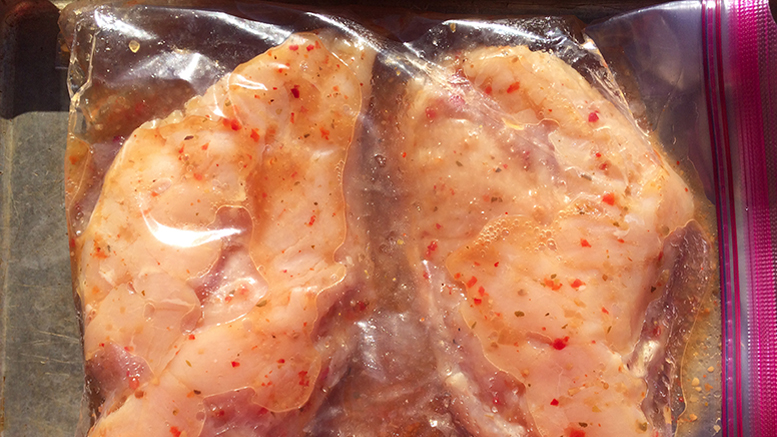By John Carlson—
Ever since learning about the stuff a couple weeks ago, I have been obsessed with lab-grown chicken.
Have you read about it?
It’s chicken … grown in a laboratory.
And yeah, it’s just the meat, minus those pesky feathers, feet and beaks, along with the wattles and other icky chicken parts.
How did they – “they” being the folks who have hopped aboard the laboratory chicken-growing bandwagon – accomplish this? As a guy who at the height of his science career flunked his first two grading periods of seventh-grade biology, you could tell me but I wouldn’t understand. In reading a story about it, however, I vaguely recall seeing two words, “Singapore” and “cultured.”
Having never been to Singapore, I don’t know much about it, either, but I do know its reputation as an incredibly clean country. The courts there will sentence you to a butt-whooping with a bamboo rod for spitting your Double Bubble bubble gum out onto the sidewalk. Having walked through gum more than once over here on America’s lawless sidewalks, all I can say to that is, “Give ‘em another whack for me, yer honor!”
More to the point, if Singaporeans are so persnickety about spitting out chewing gum, it only stands to reason they can be trusted to grow tasty chicken meat in labs without accidentally contaminating it with filet of cat.
That’s why the lab chicken is being created in Singapore, I guess.
If there is one thing I definitely know about lab-grown chicken, though, it’s that nobody is going to slip any into our refrigerator. Already a wannabe vegetarian, Nancy regards scientifically tweaked meat suspiciously. It fills her with loathing, walking a grocery store aisle seeing packages of genetically altered chicken breasts so huge, they could be poking from inside one of Dolly Parton’s T-shirts.
So, eating something that started out as a mere smear of chicken cells under a microscope? Long as Nancy runs our kitchen, it’s off the menu at Casa del Carlson.
For those of us who would be willing to gobble down some tasty lab meat under certain circumstances, another discouraging fact is that test-tube pork chops apparently remain a long way off.
The problem, I have surmised, is that pigs are considered low-class animals, “wallowing” around in the mud, “grunting” their porcine heads off and occasionally “eating their farmers” who are unfortunate enough to suffer heart attacks inside the hog pen.
The article I read was very clear on this point: When it comes to growing your supper’s main dish in a laboratory, meat scientists aim for “cultured” meat, such as that apparently found in high-class chickens. Sadly, exactly what level of culture is required of the chicken was unspecified. With the meat chunks presumably lacking eyes and ears, an appreciation of music, literature or sculpture seems like a long shot.
Also disturbingly, this article referred to lab chicken as “meat product.” This sent a chill down my spine.
Face it. Even if eating “meat product” becomes widespread, you’re not likely to see customers lined up outside a Buffalo Wild Wings to order a dozen boneless “meat products” doused in Asian Zing. The word product just doesn’t scream, “Seriously, people! I’m meat! Eat me!” For many of us, this perception is based on traumatic experiences with “cheese product,” which has been around for a while. If it turns out “meat product” tastes as unlike actual meat as “cheese product” tastes unlike actual slices of hearty Gorgonzola, I will be limiting its consumption to mousetraps and dogs snacks.
It also didn’t help that this story said lab meat product is prepared in things called “bio-reactors.”
“Bio-reactors” sound a lot less tasty than “frying pans.”
Sure, growing chicken in labs heralds a brave new world of human meat procurement. But wasn’t a bio-reactor what turned mild-mannered Bruce Banner into The Incredible Hulk, an unreasonably cranky person the color of Brussels sprouts?
I’ve never been all that ambitious, but I do intend to go through life without ever turning the color of Brussels sprouts.
No, when I think of tasty food preparation, the only bio-reactor I want involved is a heavy iron skillet, the kind my Grandma Smith used. Through that bio-reactor, fully supplied with the bio-reactor fuel called “lard,” she transformed typical chicken chunks into fried chicken worth dying for.
Speaking of which, presumably growing chicken meat in a lab will bypass serious ethical issues many folks face regarding the killing and eating of animals.
Or will it?
Seems to me there are numerous questions regarding lab-grown chicken for animal ethicists to tackle. Does lab-grown chicken, by some remote measure, start out alive? If so, does a chunk of lab-grown chicken have a soul? Plus, how do you tell it’s dead before you cook it? Even more to the point, is it immoral to bring a chunk of chicken into this world, simply to hack it to pieces for a wok full of moo goo gai pan?
Anyway, thanks loads, Singapore. Who knew a frickin’ chicken could get so complicated?.
John’s weekly columns are sponsored by Beasley & Gilkison, Muncie’s trusted attorneys for over 120 years.
About Beasley & Gilkison
We listen, analyze your unique situation, and prepare a course of action that best fits your needs. Contact one of our attorneys to schedule a consultation, or for more information, call 765-289-0661 or visit our Facebook page or website at beasleylaw.com.

A former longtime feature writer and columnist for The Star Press in Muncie, Indiana, John Carlson is a storyteller with an unflagging appreciation for the wonderful people of East Central Indiana and the tales of their lives, be they funny, poignant, inspirational or all three. John’s columns appear on MuncieJournal.com every Friday.


